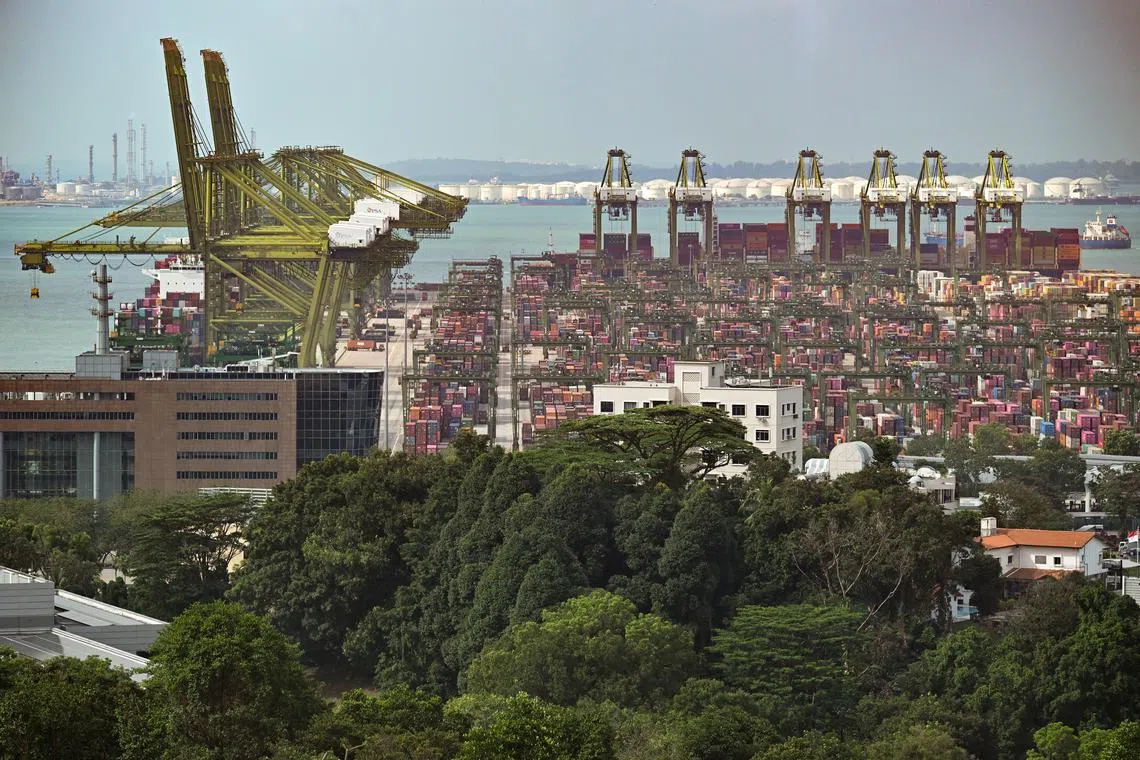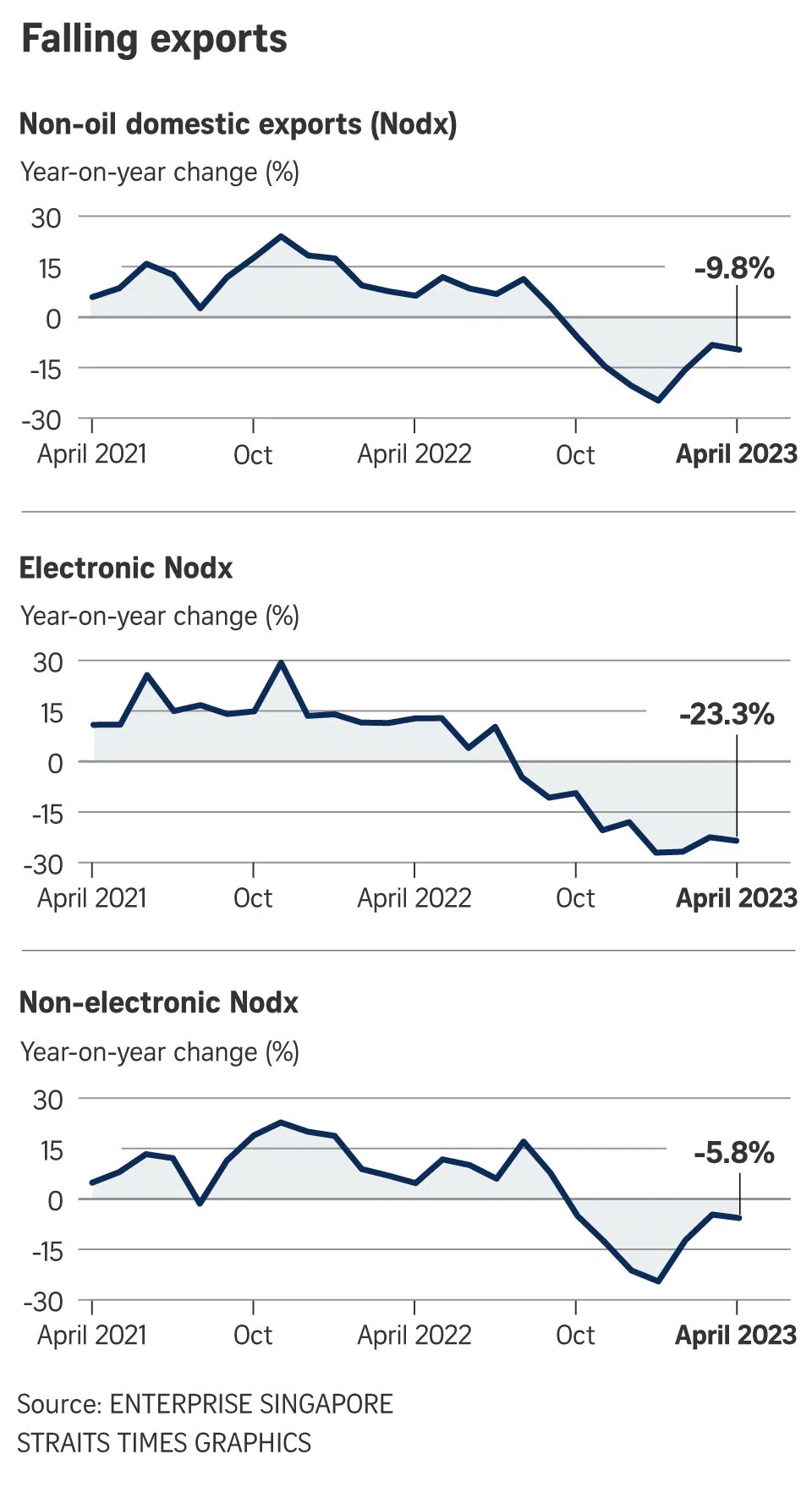Singapore key exports extend slump with 9.8% fall in April
Sign up now: Get ST's newsletters delivered to your inbox

Singapore’s key exports posted its seventh month of year-on-year contraction in April.
ST PHOTO: LIM YAOHUI
Follow topic:
SINGAPORE - Singapore’s key exports posted their seventh consecutive month of year-on-year contraction in April, weighed down by both electronic and non-electronic products, prompting some economists to predict a few more months of declines before any improvements in the second half of 2023.
Non-oil domestic exports (Nodx) fell 9.8 per cent year on year in April, following an 8.3 per cent decline in March, data from Enterprise Singapore showed on Wednesday.
This was slightly worse than the 9.4 per cent contraction forecast by economists in a Reuters poll and the 9.6 per cent drop in a Bloomberg poll.
The main drag was the 23.3 per cent year-on-year slide in electronic shipments, which came after a 22.3 per cent tumble in March. This was led by lower shipments in integrated circuits, personal computers and disk media products, which contracted 21.1 per cent, 50.3 per cent and 41.6 per cent respectively.
Non-electronic Nodx fell by 5.8 per cent, following a 4.7 per cent drop in March. The drop was led by contractions in petrochemicals, primary chemicals and food preparations.
Ms Selena Ling, chief economist and head of treasury research and strategy at OCBC Bank, said: “Overall, external demand conditions remain lacklustre, which may imply Nodx momentum to remain mired in year-on-year contraction territory until the third quarter of 2023.
“We retain our 2023 Nodx growth forecast of minus 3 per cent year on year.”
A key concern was the nine consecutive months of declines posted by electronic exports.
“Global electronics demand conditions may still be searching for a trough and the anticipated recovery in the second half of 2023 for the global electronics industry looks elusive,” Ms Ling said.
Even the surge in pharmaceutical exports by 126.7 per cent in April compared with a year earlier was insufficient to offset the electronics slump, she noted.
On a seasonally adjusted month-on-month basis, Nodx rose 2.7 per cent to $16.1 billion, due to the jump in pharmaceutical exports.
Total trade declined by 18.8 per cent in April compared with the same month in 2022, extending the 8.6 per cent decrease in March.
Nodx to seven of Singapore’s top 10 markets, including Asean destinations, saw double-digit contractions in April.
However, Nodx to the United States, the European Union and South Korea bucked the trend, rising 40.7 per cent, 38.9 per cent and 4.3 per cent respectively.

Nodx to China shrank 20.9 per cent in April, on lower shipments of petrochemicals, pharmaceuticals and integrated circuits.
Ms Ling said it remains to be seen if Nodx demand from China would be sustained, given the weaker pace of the country’s economic recovery since borders were reopened earlier in 2023.
Exports to Malaysia contracted by 35 per cent in April, due to declines in integrated circuits, primary chemicals and specialised machinery.
Nodx to Taiwan declined by 27.5 per cent, following the contraction in specialised machinery, integrated circuits and parts.
Looking ahead, Singapore’s trade-reliant economy looks vulnerable to risk, in the light of downbeat trade data from Indonesia, Taiwan and South Korea.
Ms Ling said: “Even assuming that Nodx demand from the United States continues to hold up in the near term, notwithstanding recent recession concerns from the market and still hawkish (US Federal Reserve) rhetoric, the global demand engine prognosis still looks vulnerable, especially if China’s reopening pace remains tepid.
“The risk remains that the global electronics industry demand turnaround may be pushed out from the second half of 2023 to end-2023 or even early 2024, which would not be music to the ears of key electronics exporters.”
Mr Euben Paracuelles, senior economist at Nomura, expects the Singapore economy to grow at 1.1 per cent in 2023, compared with the Government’s estimate of 0.5 per cent to 2.5 per cent, due to the weak external demand. Nomura reckoned the electronics downcycle is unlikely to bottom out until the second half of 2023.
He said: “We still expect the surge in volatile pharmaceutical exports to be temporary, given the extent of the surge in the past two months.
“However, this could also reflect new production facilities, such as plants from Thermo Fisher Scientific and BioNTech, which became operational in 2023 and likely provided some offset to weak exports of other products.”
UOB senior economist Alvin Liew said that while Nodx to the US and EU fared better in April, “it may have been driven by non-electronics, especially pharmaceuticals, and this might not be sustainable”.
He is projecting Nodx for the full year to contract by 5.5 per cent.
Mr Liew said: “We continue to expect economic slowdown in the developed markets on the back of a tighter monetary policy environment, and this could be made worse by ongoing weakness in the financial system, further restraining credit growth and dampening confidence.”


